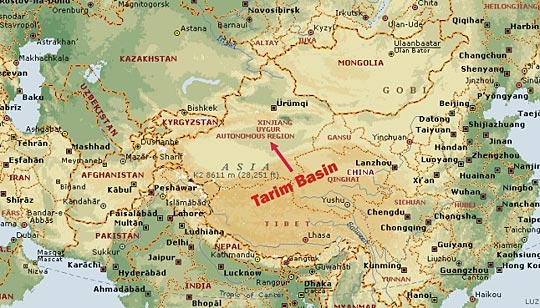One of the noteworthy events of the past week (7 Nov. 2019) has been the announcement of the
discovery of a cache of mammoth bones in San Antonio Xahuento, Tultepec, Mexico. The bones of approximately 200 individual mammoths have been found in what appears to have been large pits constructed by early humans to trap and kill the animals. It has been estimated by the archaeologists that the bones are about 15,000 years old, and they suggest that the ancients had developed this hunting strategy as an advancement of the traditional practice of only hunting individual wounded or trapped animals.
I think that this find is very interesting, not in the publicized sense of revealing an advancement in the skills of the aboriginal native Americans, but one of validating the Jaredites familiarity with elephants, and their use of them for labor (and also possibly for food). Of course the main body of the Jaredites inhabited parts of the Americas from about 2500 BC to about 200 BC, so the estimated age of these mammoths predates the time of the Jaredites by perhaps 12,000 years. So could these bones have been from Jaredite-age mammoths? Could the experts be that wrong, or is my theorized dating completely off?
First let's look at how the experts arrived at this early date for the mammoth bones. First, they have
compared the bones with the adjacent strata, which indeed is of their postulated age. But if the ancients had dug a pit and the bones were secondary, then they should not correspond with the age of the strata of the pit which would obviously be older than the fill. Secondly, the researchers have also indicated that there is dust from the eruption of a nearby volcano on top of the bones. This eruption is dated to about 11,000 BC. This would invalidate a later date. But it is entirely possible that this dusting is secondary, falling in from the side walls of the trench or pit. Also it is possible that the dating of the eruption may be in error.
And lastly, it is accepted dogma that the Columbian mammoths became extinct on or before 10,000 BC. This last event has been disputed in an excellent research paper by Scott Drenner who has shown that there are much more recent dates for mammoth remains. These recent carbon dates are normally disputed by the scholars who label them as "anomalous" and routinely discard them.
Another item of interest is that the bones have apparently not been carbon dated. Carbon dating would give a much more accurate measure of their actual age than would contextual dating. But even though the work has been going on for some time prior to the news release, they have apparently not bothered with the carbon dating.
Another interesting fact is suggested in the above news releases; that Mexico is the second most abundant source of mammoth remains. The first would probably be the northern Eurasian region. This would mean that at one time Mexico was home to abundant herds of mammoths.
Referring to the above find, my hypothesis is that these bone deposits are evidence of the Jaredite use of the elephant species in performing their extensive heavy construction projects (Refer to previous blog on elephants, cumoms and cureloms). The remains of these monumental projects are ubiquitous throughout Mexico and are a source of wonder and awe.
Now by accepting the Book of Mormon as authentic history and scripture (which I do), we also accept the included Book of Ether, which relates the history of the original Jaredite migration from the Middle East. In that book we find the reference to elephants among the Jaredites: "and there were elephants and cureloms and cumoms; all of which were useful unto man, and more especially the elephants and cureloms and cumoms (Ether 9:19)." Scott Drenner, in the paper referenced above, has shown that the Columbian Mammoth was the original Jaredite elephant, the Curelom was the extinct mastodon, and that the Cumom was the extinct Cuvieroniinae (or Gomphothere), which are all similar species. From the above we can infer that the Jaredites bred, raised, trained and worked these three groups and found them very useful.
Here I will include a quote from my previous blog on the husbandry of elephants: "The husbandry of elephants is very interesting and different from most domestic species. This is due to their lengthy gestation, and the long juvenile phase. Elephants will carry their young for 18-22 months, and the young infant will generally not be ready for heavy work until they are almost 20 years old. As a result there are many years of unproductive use, and many industrial users find that it is more economical to let them run wild and then catch and train them when they are fully grown." It is likely that the Jaredites followed similar practices, allowing the animals to run wild until they were ready for use, and then capturing and training them. This may explain the pits and traps which were found containing all the bones.
Now if the Jaredites had used the above menitoned pits as traps for wild elephants, why are there bones deposited in the pits? Perhaps some of the elephants were injured and died as a result of falling into the pits. Or more likely the natives could have used the pits to dispose of the remains of old or dead animals. Hopefully future research will give us more detailed information.
I have included below some of the references to these finds. Most are in Spanish, but the written ones will give a rough translation using Google Translate. The videos give visual information but will probably be unintelligible to non-Spanish speaking persons.
Spanish paper: Descubren en Tultepec, Estado de México, contexto inédito de cacería y destazamiento de mamuts. https://www.inah.gob.mx/attachments/article/8647/20191106_boleti%CC%81n_463.pdf
Videos
https://www.upi.com/Science_News/2019/11/07/Anthropologists-unearth-remains-of-mammoths-trapped-in-15000-year-old-pits/5201573136924/?ls=1
https://www.youtube.com/watch?v=9c0G-iLZg_E
https://www.youtube.com/watch?v=3oTpqV9tzBI
Mexican TV series "Following the Footprints of Mammoths in Mexico" (in Spanish) One, Two, Three, Four.















